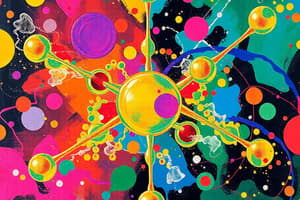Podcast
Questions and Answers
Which of the following subatomic particles is located in the nucleus of an atom?
Which of the following subatomic particles is located in the nucleus of an atom?
- Electrons
- Protons (correct)
- Neutrons (correct)
- All of the above
What is the primary difference between isotopes of the same element?
What is the primary difference between isotopes of the same element?
- Number of subatomic particles
- Number of electrons
- Number of neutrons (correct)
- Number of protons
What is the mass number of an atom that has 8 protons and 10 neutrons?
What is the mass number of an atom that has 8 protons and 10 neutrons?
- 2
- 10
- 8
- 18 (correct)
Which of the following statements is TRUE regarding the relative size of the nucleus and the electron cloud in an atom?
Which of the following statements is TRUE regarding the relative size of the nucleus and the electron cloud in an atom?
Which of the following statements is TRUE about the charge of an atom?
Which of the following statements is TRUE about the charge of an atom?
Which of the following isotopes of carbon is radioactive?
Which of the following isotopes of carbon is radioactive?
What is the difference between the atomic number and the mass number of an atom?
What is the difference between the atomic number and the mass number of an atom?
If an atom has 17 protons and 18 neutrons, what is its atomic number and mass number?
If an atom has 17 protons and 18 neutrons, what is its atomic number and mass number?
Flashcards
Atom
Atom
The smallest unit of matter retaining element properties.
Proton
Proton
A positively charged subatomic particle.
Electron
Electron
A negatively charged subatomic particle.
Neutron
Neutron
Signup and view all the flashcards
Atomic Number
Atomic Number
Signup and view all the flashcards
Mass Number
Mass Number
Signup and view all the flashcards
Isotopes
Isotopes
Signup and view all the flashcards
Stable vs Radioactive Isotopes
Stable vs Radioactive Isotopes
Signup and view all the flashcards
Study Notes
Atoms Consist of Subatomic Particles
- Atoms are the smallest unit of matter that retains an element's properties.
- Atoms consist of protons, neutrons, and electrons.
Subatomic Particles
- Protons have a positive charge (+).
- Electrons have a negative charge (-).
- Neutrons have no charge.
Atomic Number
- The atomic number of an element is the number of protons in its atoms.
- Elements have unique numbers of protons.
- Every atom of a specific element has the same number of protons.
Mass Number
- The mass number of an atom is the total number of protons and neutrons in its nucleus.
- Protons and neutrons have nearly the same mass.
- Electrons have a much smaller mass.
Isotopes
- Isotopes of an element have the same number of protons but different numbers of neutrons.
- Isotopes have the same atomic number, but different mass numbers.
Atomic Mass
- Atomic mass is approximately equal to the mass number.
- Atomic mass is expressed in daltons.
Models of Atoms
- Models of atoms show electrons orbiting the nucleus.
- Current models show electrons as a cloud around the nucleus.
- Models are not drawn to scale. Nuclei are much smaller than electron clouds.
Radioactive Isotopes
- Radioactive isotopes have unstable nuclei.
- Radioactive decay releases particles and energy.
- Radioactive decay can damage cells but also has uses in dating and research.
Studying That Suits You
Use AI to generate personalized quizzes and flashcards to suit your learning preferences.



